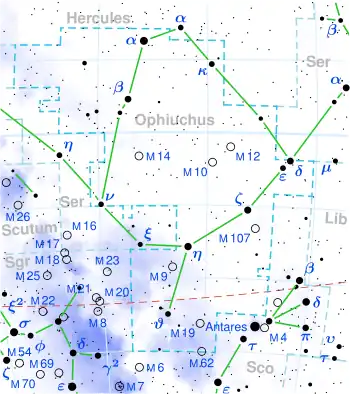 | |
| Observation data Epoch J2000 Equinox J2000 | |
|---|---|
| Constellation | Ophiuchus |
| Right ascension | 18h 07m 18.35888s[1] |
| Declination | +08° 44′ 01.9181″[1] |
| Apparent magnitude (V) | 4.64[2] |
| Characteristics | |
| Spectral type | G8III[3] |
| U−B color index | +0.73[4] |
| B−V color index | +0.97[4] |
| Astrometry | |
| Radial velocity (Rv) | −3.00±0.09[5] km/s |
| Proper motion (μ) | RA: +9.857[1] mas/yr Dec.: +29.770[1] mas/yr |
| Parallax (π) | 13.1352 ± 0.1891 mas[1] |
| Distance | 248 ± 4 ly (76 ± 1 pc) |
| Absolute magnitude (MV) | 0.03[2] |
| Details[6] | |
| Mass | 2.87±0.09 M☉ |
| Radius | 12.55+0.27 −0.34[1] R☉ |
| Luminosity | 88.8±1.5[1] L☉ |
| Surface gravity (log g) | 3.00±0.02 cgs |
| Temperature | 5,001+70 −52[1] K |
| Metallicity [Fe/H] | 0.10±0.01 dex |
| Rotational velocity (v sin i) | 0.32±0.45 km/s |
| Age | 400±30 Gyr |
| Other designations | |
| Database references | |
| SIMBAD | data |
71 Ophiuchi is a single[8] star in the equatorial constellation of Ophiuchus. It is visible to the naked eye as a faint, yellow-hued point of light with an apparent visual magnitude of 4.64.[2] The star is located approximately 273 light years away from the Sun based on parallax,[9] and is moving closer with a radial velocity of −3 km/s.[5]
At the estimated age of 400 million years,[6] this is an aging giant star with a stellar classification of G8III,[3] having exhausted the supply of hydrogen at its core and expanded to around 13[1] times the Sun's radius. It is a red clump giant,[10] which means it is on the horizontal branch and is generating energy through helium fusion at its core. The star has 2.9 times the mass of the Sun and is radiating 89 times the Sun's luminosity from its swollen photosphere at an effective temperature of 5,001 K.[6]
References
- 1 2 3 4 5 6 7 8 9 Brown, A. G. A.; et al. (Gaia collaboration) (August 2018). "Gaia Data Release 2: Summary of the contents and survey properties". Astronomy & Astrophysics. 616. A1. arXiv:1804.09365. Bibcode:2018A&A...616A...1G. doi:10.1051/0004-6361/201833051. Gaia DR2 record for this source at VizieR.
- 1 2 3 Anderson, E.; Francis, Ch. (2012). "XHIP: An extended hipparcos compilation". Astronomy Letters. 38 (5): 331. arXiv:1108.4971. Bibcode:2012AstL...38..331A. doi:10.1134/S1063773712050015. S2CID 119257644. Vizier catalog entry
- 1 2 Hoffleit, D.; Warren, W. H. (1995). "VizieR Online Data Catalog: Bright Star Catalogue, 5th Revised Ed. (Hoffleit+, 1991)". VizieR On-line Data Catalog: V/50. Originally Published in: 1964BS....C......0H. 5050. Bibcode:1995yCat.5050....0H.
- 1 2 Mallama, A. (2014). "Sloan Magnitudes for the Brightest Stars". The Journal of the American Association of Variable Star Observers. 42 (2): 443. Bibcode:2014JAVSO..42..443M.Vizier catalog entry
- 1 2 Jofré, E.; Petrucci, R.; Saffe, C.; Saker, L.; Artur de la Villarmois, E.; Chavero, C.; Gómez, M.; Mauas, P. J. D. (2015). "Stellar parameters and chemical abundances of 223 evolved stars with and without planets". Astronomy & Astrophysics. 574: A50. arXiv:1410.6422. Bibcode:2015A&A...574A..50J. doi:10.1051/0004-6361/201424474. S2CID 53666931. Vizier catalog entry
- 1 2 3 Jofré, E.; et al. (2015). "Stellar parameters and chemical abundances of 223 evolved stars with and without planets". Astronomy & Astrophysics. 574: A50. arXiv:1410.6422. Bibcode:2015A&A...574A..50J. doi:10.1051/0004-6361/201424474. S2CID 53666931. A50.
- ↑ "71 Oph". SIMBAD. Centre de données astronomiques de Strasbourg. Retrieved 2019-06-21.
- ↑ Eggleton, P. P.; Tokovinin, A. A. (September 2008). "A catalogue of multiplicity among bright stellar systems". Monthly Notices of the Royal Astronomical Society. 389 (2): 869–879. arXiv:0806.2878. Bibcode:2008MNRAS.389..869E. doi:10.1111/j.1365-2966.2008.13596.x. S2CID 14878976.
- ↑ Van Leeuwen, F. (2007). "Validation of the new Hipparcos reduction". Astronomy and Astrophysics. 474 (2): 653–664. arXiv:0708.1752. Bibcode:2007A&A...474..653V. doi:10.1051/0004-6361:20078357. S2CID 18759600. Vizier catalog entry
- ↑ Alves, David R. (August 2000). "K-Band Calibration of the Red Clump Luminosity". The Astrophysical Journal. 539 (2): 732–741. arXiv:astro-ph/0003329. Bibcode:2000ApJ...539..732A. doi:10.1086/309278. S2CID 16673121.